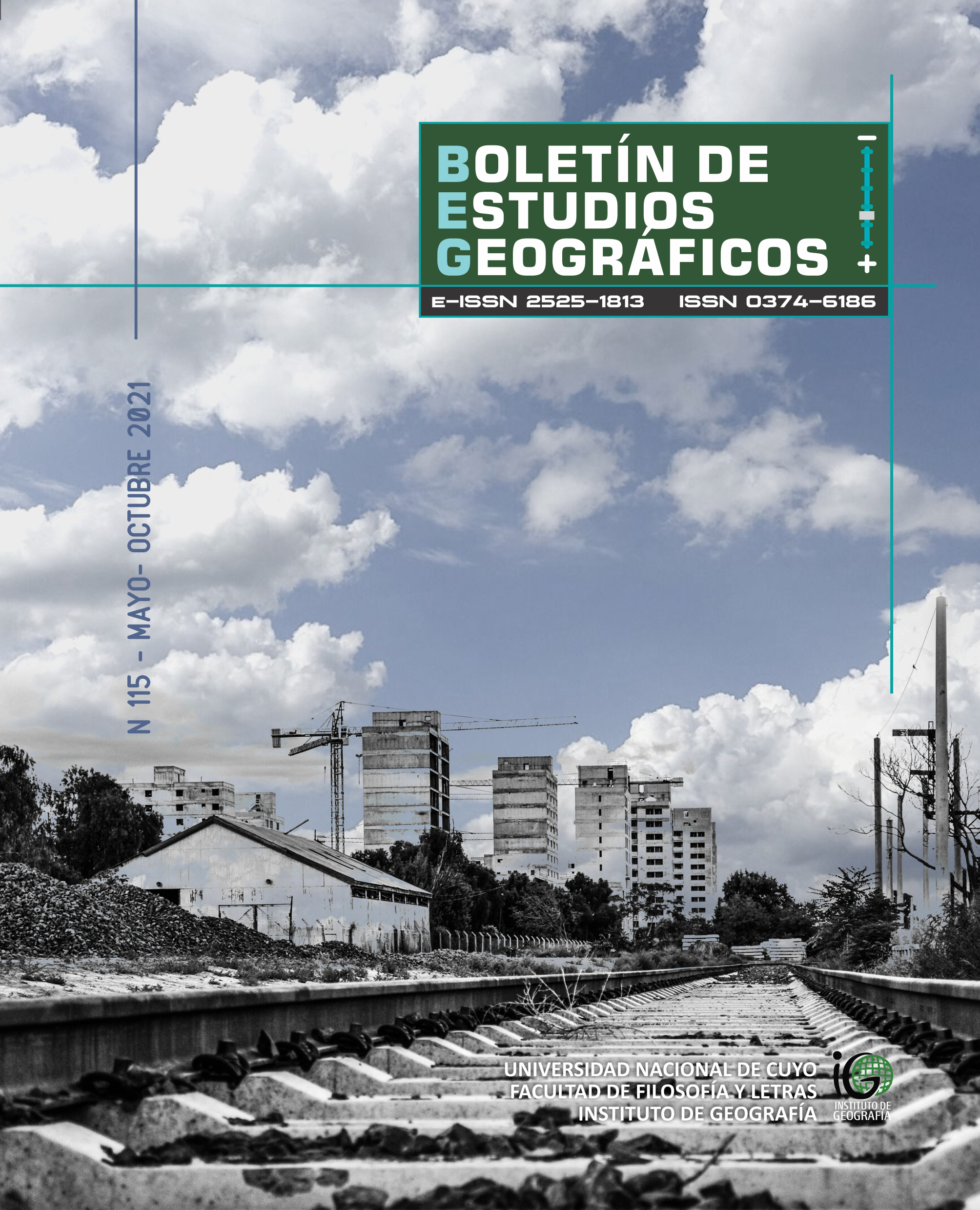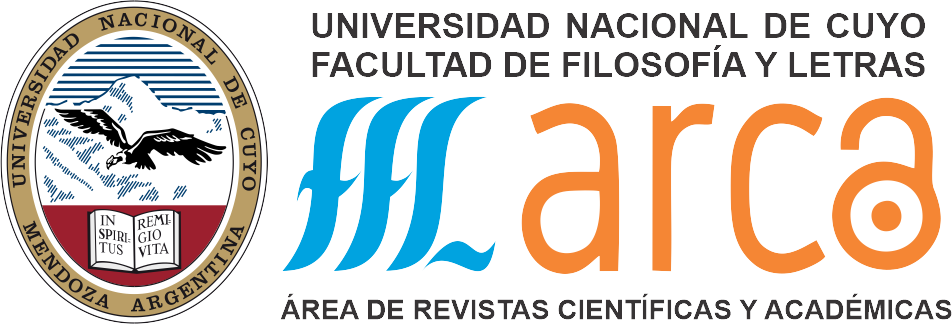Impact of the evolution of the urban built-up area on surface runoff in the city of Tandil, Buenos Aires, Argentina: a simulation scenario with HEC-RAS
DOI:
https://doi.org/10.48162/rev.40.003Keywords:
Hydrodynamic modeling, Urban basin, Tandil, HEC-RASAbstract
The following article is part of an ongoing investigation that studies and deepens the processes involved in the hydrodynamic modeling of an urban basin. This concept starts from considering the construction of a hydrological model that mainly takes into account the drainage surface and a hydraulic model defined by the characteristics and parameters of the infrastructure that the basin presents.
In the last ten years, hydrological models have been used to assess, understand and analyze runoff dynamics in basin systems, making it possible to predict short and medium-term scenarios from the simulation of events of different intensities and socio-spatial implications.
The objective of this work is to build a mathematical model of flood modeling for the urban basin of the city of Tandil using the HEC-RAS tool. The parameters that define the construction of the numerical model depend on the topography or Digital Land Model, the drainage network, the urban expansion models that established the current territorial configuration of the urban space, the roughness coefficients differentiating the zoning within the city and the rainfall flow determined by its intensity and speed. In this case, the only “input” variable that wasn’t used was the geometric drainage network. From the implemented tool, it was possible to carry out simulations for the years 1996 and 2011. Their analysis allowed us to know the effect of the changes in land cover on the surface runoff, essential to evaluate and recommend management policies and planning of some factors. For example, the treatment, maintenance and extension of the storm drainage network, restrictions on densification in the building, generation of new green spaces that act as infiltration buffers, among other semi-structural measures to current urban planning.
References
Australian Emergency Management Institute (AEMI) (2013). Managing the floodplain: A guide to best practice in flood risk management in Australia, Australian Emergency Handbook (7), Canberra.
Australian Institute for Disaster Resilience (AIDR) (2014). Australian Disaster Resilience Guideline 7-3: Technical flood risk management guideline: Flood hazard, 2014, CC BY-NC.
Carballo, T.; Goldberg, S. (2014). Comunidad e información ambiental del riesgo. Las inundaciones y el Río Luján. Buenos Aires: Editorial Dunken.
Collazos, G.; Villanueva, I.; Briceño, N.; Cazenave, G.; Guevara, C.; y Blanco, M. (2018). Modelo bidimensional de inundación urbana de la ciudad de Azul (Argentina) con herramientas de uso libre. XXVIII Congreso Latinoamericano de Hidráulica. Buenos Aires, Argentina, septiembre de 2018.,2064-2075.
DeVantier, B. A. y Feldman, A. D. (1993). Review of GIS Applications in Hydrologic Modeling. Journal of Water Resources Planning and Management, 119, (2), Paper 3607, 246-259
Ellis, E. A.; Romero, J. A.; Hernández, I.U.; Gallo, C. A. y Alanís, J. L. (2012). Evaluación geográfica de áreas susceptibles a inundación en la cuenca del río Tuxpan, Veracruz. Avances en Investigación Agropecuaria. 2012. 16(1): 7-28.
Fernández Pato, J. y García Navarro, P. (2018). Development of a New Simulation Tool Coupling a 2D Finite Volume Overland Flow Model and a Drainage Network Model. Geosciences. 8-288.
Ferrando A. y Francisco J. (2006). Sobre inundaciones y anegamientos. Revista de Urbanismo, (15), Facultad de Arquitectura, Universidad de Chile. Disponible en: https://web.uchile.cl/vignette/revistaurbanismo/CDA/urb_complex/0,1311,SCID%253D19141%2526ISID%253D668%2526IDG%253D2%2526ACT%253D0%2526PRT%253D19132,00.html
Fuschini Mejia, M. (1998) El agua en las llanuras. En Durán, D. (compiladora). La Argentina Ambiental. Naturaleza y Sociedad. Buenos Aires: Lugar.
García, R. (2006). Sistemas complejos: conceptos, método y fundamentación epistemológica de la investigación interdisciplinaria. Barcelona: Editorial Gedisa.
González, S., Torchia, N. y Viand, J. (2015). Inundaciones urbanas, En: Secretaría de Ambiente y Desarrollo Sustentable. Inundaciones urbanas y cambio climático: Recomendaciones para la gestión, Ciudad Autónoma de Buenos Aires, 33-47.
HEC-RAS (2016a). River Analysis System. User's Manual. Version 5.0. US Army Corps of Engineers Institute for Water Resources. Hydrologic Engineering Center. Davis. Disponible en: www.hec.usace.army.mil.
HEC-RAS. (2016b). River Analysis System. 2D Modeling. User’s Manual. US Army Corps of Engineers. Institute for Water Resources. Hydrologic Engineering Center. Davis. Disponible en: www.hec.usace.army.mil.
Henríquez Ruiz, C. (2009). El proceso de urbanización en la cuenca del río Chillán y su capacidad adaptativa ante precipitaciones extremas. Estudios Geográficos, LXX, (266), 155-179.
Herzer, H.; Rodríguez, Carla.; Celis, A.; Bartolomé, M. y Caputo, G. (2002). Convivir con el riesgo o la gestión del riesgo. LA RED. Disponible en: https://www.researchgate.net/profile/Alejandra_Celis/publication/237638971_CONVIVIR_CON_EL_RIESGO_O_LA_GESTION_DEL_RIESGO1/links/5591847c08ae1e1f9baff784.pdf
Johnston, R. J.; Gregory, D.; Smith, D. (1987). Diccionario de Geografía Humana, Madrid: Alianza.
La Macchia, M.L. (2015). Modelización y análisis espacial del drenaje urbano de la ciudad de Tandil mediante Tecnologías de la información Geográfica. Tesis de Licenciatura en Geografía. Universidad Nacional del Centro de la Provincia de Buenos Aires.
Linares, S. (2012). Análisis y modelización de la segregación socioespacial en ciudades medias bonaerenses mediante Sistemas de Información Geográfica: Pergamino, Olavarría y Tandil (1991-2001). Revista Geográfica de Valparaíso, Instituto de Geografía, Pontificia Universidad Católica de Valparaíso. Valparaíso (Chile), (45), 3-22.
Linares, S.; Picone, N. (2018). Application of Remote Sensing and Cellular Automata Model to Analyze and Simulate Urban Density Changes. En Qihao Weng. Edited by Qihao Weng, Dale Quattrochi, and Paolo E. Gamba. Chapter 10. Urban Remote Sensing. Second Edition. Remote Sensing Applications. Series Editor, 213-228. Indiana, USA: Indiana State University. Terre Haute.
López Trigal, Lorenzo (Dir.) (2015). Diccionario de Geografía aplicada y profesional. Terminología de análisis, planificación y gestión del territorio. Ed. Universidad de León.
Melesse, A.; Wang, X. (2007). Impervious Surface Area Dynamics and Storm Runoff Response. Remote Sensing of Impervious Surfaces, 369-384.
Natenzon, C. (1998). Riesgo, vulnerabilidad e incertidumbre. Desastres por inundaciones en Argentina. PIRNA. Facultad de Filosofía y Letras. UBA.
Pereyra A. (2014). El riesgo a las inundaciones en la trama de los eventos extremos. En Carballo, T.; Goldberg, S. Comunidad e información ambiental del riesgo. Las inundaciones y el Río Luján. Buenos Aires: Editorial Dunken. 13-26.
Sánchez, F. J. y Lastra, J., coords (2011). Guía metodológica para el desarrollo del Sistema Nacional de Cartografía de Zonas Inundables. Madrid: Ministerio de Medio Ambiente y Medio Rural y Marino.
Scioli, C. (2009). Modelación del escurrimiento superficial en áreas de llanura: Implementación y calibración de un modelo distribuido de grilla. Maestría en Recursos Hídricos en zonas de llanura. Facultad de Ciencias Exactas, Ingeniería y Agrimensura. Universidad Nacional del Rosario.
Tucci, C. (2005). Gestão de inundações urbanas. Porto Alegre: UNESCO-PHI.
Vanneuville W., De Maeyer Ph., Maeghe K. & Mostaert F. (2003). Model the effects of a flood in the Dender catchment, based on a risk methodology. Society of Cartography Bulletin, 37 (2), 59-64.
Downloads
Published
How to Cite
Issue
Section
License

This work is licensed under a Creative Commons Attribution-NonCommercial 4.0 International License.



























